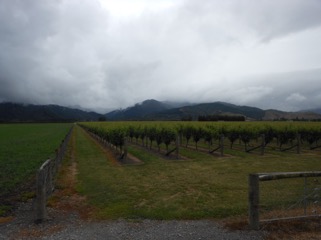Vineyards, Blenheim and Puhi Puhi

Marita3
Mark & Helen Syrett
Sat 20 Dec 2014 06:56
| 42:16.198S 178: 44.262E Thursday 18 December The forecast was correct and it was right—rain all day. The only thing to do was to wet our insides as well so a little wine tasting seemed appropriate. The problem with wine tasting when you are driving is that you have to spit most of it out and that goes very much against the grain. We randomly picked four vineyards: Giesen (three German brothers), Huia (organic), Cloudy Bay (a lovely place but as expected expensive) and Hunters ( a chatty sales lady!). We slurped our way through 4 or 5 tastings at each place usually Sauvignon, Chardonnay, Pinot Noir (white and red) and Merlot. They were all excellent and we bought a couple of bottles at each place. Hunters was probably best value for money with a really good Chardonnay; we also bought a bottle of fizz there for Christmas Day. The organic vineyard with lots of weeds  Cloudy Bay wine tasting showroom  vines everywhere!  A drive into Blenheim and we were soon parked outside the Aviation Museum which we had been told by a number of Kiwis was a must do. It was very good and definitely worth seeing. British and Italian, French and German planes of WW!. The museum is funded by Peter Jackson who has made the Hobbit films.   A British plane with the engine behind the pilot so he didn’t shoot the propellor off!  There was also a lot of war memorabilia in the form of uniforms, stories of bravery verging on the suicidal. Many of these aeroplanes still fly and they have an air show every year when the are rolled out of the hangar and flown. We the decided to head on South as the forecast was for better weather in that direction. We stopped at on the roadside to look at the seal colony, young and old, at Ohau   We then found what they call a “conservation camping site” ——the Puhi Puhi camp site. These ‘conservation camp sites’ are basic sites normally in the middle of nowhere and have nothing but mown grass, some tables and a loo, which is like a permanent portaloo. It was 6 km up into the hills along a narrow, un-metalled road with edges that had washed away in places. As we could not see the hills because of the rain and low cloud it was all rather grim but we persevered. When we finally arrived there was one tent but no sign of life or indeed a car. After a debate we decided to stay! Other campers mainly with cars and tents arrived later so we were not totally on our own. The river that ran alongside obviously carried a lot of water when the melt occurred.  In the morning it all looked rather different—the snow topped mountains could be seen from the Mighty.  According to an information board at the campsite this place used to be a large timber and logging place during the deforestation in 1840/1850. There was even a school there for the 5 to10 year olds with a schoolteacher who had come out from England. A very hard life and life expectancy was short. |